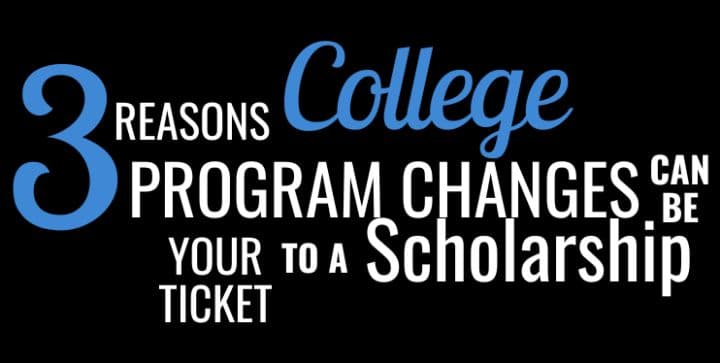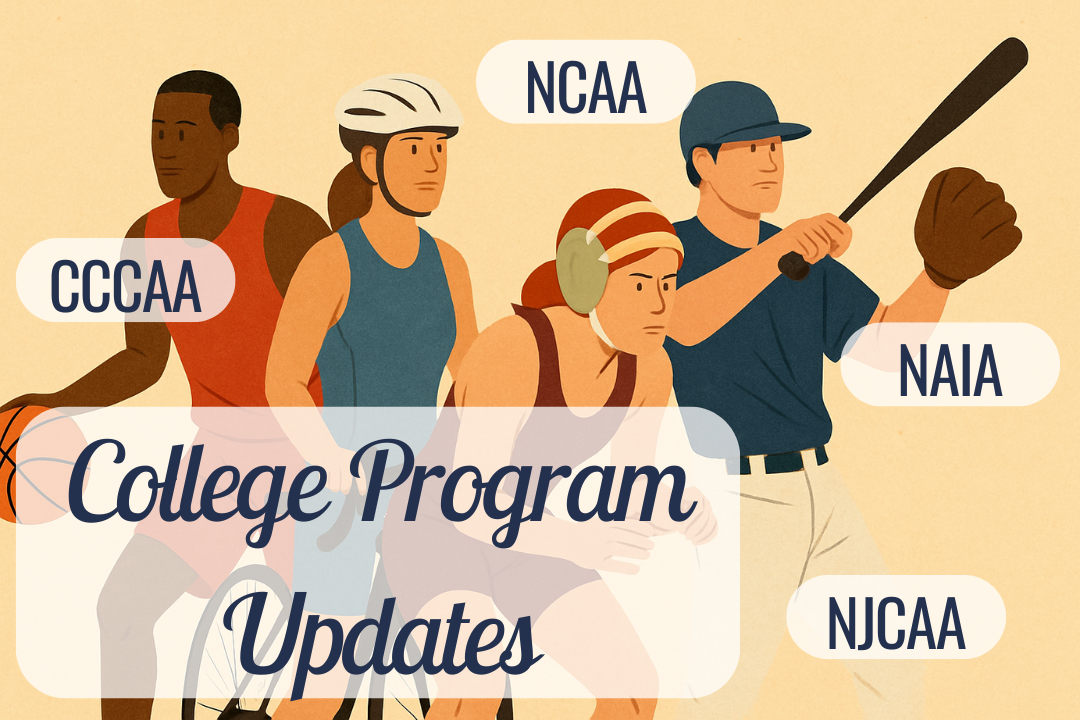3 Reasons College Program Changes Can be Your Ticket to a Scholarship

With the season 2024-2025 coming to a close, it's one of the key times of the year for us to take care of plenty of data updates in our college database. Coaches' contact details get updated and exciting news announcements within the world of college athletics are processed, all with the goal of making available the most accurate data possible.
If you understand that the college landscape is not a static, but rather a very dynamic one, you have taken a great step towards getting recruited when the time comes.
In this Friday Scholarship Guide, we will walk you through the Top 3 reasons, why program changes can be a brilliant opportunity.
First off, let's break down what we actually mean with "college program changes":
- Program additions
A university may decide at any time that the athletics department can start up a new sport. This could be an emerging sport (think beach volleyball, cheer or esports), a sport, which has historically been offered and is about to get reinstated or a new sport, the school sees a particular sweet spot in "the market" (such as being the only private school in the state, offering the respective sport as a varsity program). - Program cuts
Following the same logic, but for more unfortunate, often financial reasons, a university may decide to cut specific programs. Apart from financial reasons, this could also have to do with the fact that the team is unable to recruit enough athletes to be competitive. - School closures
Again very unfortunate, but school closures do happen. Unfortunately a bit more often in recent years than before, following the COVID aftermath, paired with other structural issues some schools have faced. - School mergers
To avoid closing down, some schools have merged in the past, which usually leads to one of the schools leaving the college sports scene as varsity sports stop being offered. Perhaps students can still participate. Either if they are strong enough to make the "new team" (buyer) or provided the sports continues to be offered as a club sport. - New division memberships
New universities or universities who have not had any athletics programs in the past may decide to enter the scene by becoming a NCAA, NAIA, NJCAA, USCAA or NCCAA school. Depending on division, athletic scholarships may suddenly become available, as teams strive to be competitive. - Division reclassifications
Following the same logic as above, a school could decide to transition from one division to another. At the end of the day, some divisions and its models are in direct competition and moves from the NCAA to the NAIA and vice versa have been seen in recent years. Reasons to move often follow a year-long process with strategic, financial and tactical reasons to create the best possible student athlete experience, which fits to the school overall. - Conference reclassifications
Conference realignments happen all the time. It is that big a topic in college athletics, we set aside a week in May and June to take a deep dive at all of these changes. Again, strategic considerations are key for any such moves and at times, a school switching conference to another one might be a massive factor in making a decision in favor of a team. - University name changes
The most common changes have to do with the fact that a school is allowed to change its name from "college" to "university". This has to do with the degree offerings and is more of a reputational factor than anything else.
How does this all apply to you, your recruiting process, your future conversations with college coaching staff and scholarship offers?
Let's dive right in:

- Establish contact as early as possible
Any new coach will be looking to leave a mark in the program history. That means nothing else than: "I want to bring in my recruiting class". Success is dependent on good coaching, yes, but without the right athlete material, you can be the best coach in the U.S., you won't win conference titles, let alone national championships.
Being a good coach therefore includes being strong at recruiting the right athletes for the program.
Whenever you see a news announcement of new programs being added to a school's athletics offerings, you can be certain there is a coach or "soon-to-be-announced-coach", who is dying to start recruiting.
Getting recruited is not a sprint, it's a marathon and getting on coaches' radar early or earlier than others can really pay off.
You don't want to lose out on an opportunity, just because you didn't know about it and the risk is there with new programs popping up, which don't have a history or played schedule yet. - Access scholarship offers sooner
Imagine you come across the announcement of a new football program (see below Mount Mercy University in 2026). Now imagine there are 0 players on the roster, unless there has been some sort of club team, the coach can draw off. That makes for a lot of players, a coach needs to recruit.
Funnily enough, this can even lead to a situation, in which a men's volleyball program starts its inaugural season with talented athletes (soccer players), who are open to trying out a different sport, but that's a whole different story.
Back to what that means to you and the scholarship implications.
Yes, there is a cap on scholarship money. Due to external rules, which a member school needs to comply with, but also due to internal rules, which may cap the maximum percent of aid per student athlete. You don't really need to care about any such cap, as you won't have insights into coaches' budgets or internal restrictions anyway.
But remember this: the pot of scholarship money can dry up, as soon as everything's been awarded and offered to athletes ... - Foresee trends / development ahead
Just because the information's out there, doesn't mean everybody else is aware of it.
Do your research, ask the right questions, read up on programs, newspaper articles, etc.
Sometimes, there is talk about a school seeking a change in conference membership or a school looking to change division. If this is something you hear or are excited about, it can give you that competitive edge over other athletes you do want to have.
At a minimum, it shows the college coach you have done your research, run your background checks and you are asking the right questions. Those are all positive factors and things, which can make you stand out.
On the other hand, imagine you speak with a coach, whose institution is in trouble and at risk of closing down - might not be the school you want to commit to, unless there are plenty of other reasons for you to consider and rank higher.
The below list of changes captures the most recent wave of program additions, reclassifications, and closures across all levels of U.S. collegiate athletics. Please note that the list is not exhaustive, but rather offers a sneek-peak into the value we provide, as the list is limited to all College Pipe users (athletes, coaches, organizations), who are being informed via a regular email newsletter.
New Programs / Program Cuts
NCAA D-I
Delaware State University
Wrestling (Women's)
Cal Poly (San Louis Obispo)
discontinues Men’s & Women’s Swimming programs.
Long Island University
Triathlon (Women’s)
Austin Peay State University
Lacrosse (Women’s)
Northern Kentucky University
Volleyball (Men’s)
and 5 more new college programs within ice hockey, golf, lacrosse & rowing
NCAA D-II
Wingate University
Rugby (Men’s)
Northeastern State University
Tennis (Men’s)
Saint Michael’s College
Outdoor Track & Field (Men’s & Women’s)
Barton College
Field Hockey (Women's)
Southwest Baptist University
Swim & Dive (Men’s & Women’s)
Volleyball (Men's)
and 5 more new college programs within rowing, field hockey, soccer & golf
NCAA D-III
Norwich University
Wrestling (Men’s & Women’s)
Alfred University
Field Hockey in Fall 2025.
Beloit College
Ice Hockey (Men's & Women’s)
Salem College adds:
Cross Country (Men's & Women’s)
Track & Field (Men's & Women’s)
Kalamazoo College
Track & Field (Men's & Women’s)
and 5 more new college programs within wrestling & golf
NAIA
Defiance College
Bowling (Women’s)
Louisiana State University–Shreveport
Bowling (Men's & Women’s) (status: varsity or club to be decided).
New College of Florida
Swimming (Men's & Women’s)
Mount Mercy University
Football in 2026.
Georgia Gwinnett College
Basketball (Men's & Women’s)
and 3 more new college programs within tennis, golf & wrestling
NJCAA / CCCAA / USCAA
5 NJCAA schools added Men’s Volleyball:
Harcum College
Brookdale CC
CUNY Kingsborough CC
Roxbury CC
Community College of Philadelphia
Colorado Northwestern CC (NJCAA I)
Wrestling (Men's)
McLennan CC (NJCAA I)
Volleyball (Women’s)
Bakersfield College (CCCAA)
Water Polo (Women’s)
Cerro Coso CC (CCCAA)
Soccer (Men's)
Regent University (USCAA)
Baseball
and 3 more new college programs within soccer, volleyball & bowling

That's already quite a lot, but there's more. Let's dive into the school closures and changes of divisional membership next
School Closures & Division Changes
NCAA D-II
- Ferrum College (NCAA III) becomes a member of NCAA II - Conference Carolinas, effective Fall 2025.
NCAA D-III
Northland College will close after the 2024–2025 academic year.
Rosemont College (NCAA D-III) merges with Villanova University (NCAA D-I) (becoming "Villanova University - Rosemont Campus") and will no longer offer varsity sports.
Bryn Athyn College discontinues all athletics programs.
NAIA
Hesston College (Kansas) transitions from NJCAA to NAIA, launching:
Baseball, Basketball (M&W), Cross Country (M&W), Golf (M), Softball (W), Track / Field (M&W), Volleyball (W)
Stanton University (California) transitions from USCAA to NAIA, launching:
Basketball, Golf, Soccer, and Tennis (all M&W).
NJCAA
Name Change: Monroe College (NJCAA)-> Monroe University
Limestone University (NCAA D-II) is not included in the above list yet (hopefully, it never will), but there is serious concern over the 2 century old institution to close down, given a massive budget deficit.
Last but not least, see the first larger conference realignments below, which have an impact on the future commitment of both swimmers and ice hockey players:
Conference Changes
NCAA D-I
- Mountain Pacific Sports Federation adds 7 new member schools to its swim championships / conference:
- California Baptist University (M&W)
- University of Idaho
- New Mexico State University
- Northern Arizona University
- Northern Colorado University
- The University of Texas Rio Grande Valley
- Utah Tech University
NCAA D-III
The Little East Conference (LEC) will sponsor men’s & women's hockey as a championship sport beginning with the 2025-26 academic year .
Found the above relevant, interesting and useful?
Check out what we have in store for you specifically at College Pipe, no matter if you are an athlete, parent, college coach or organization working with student athletes in some capacity, be it as club team, high school coach or recruiting service.
Sign up with a free profile right away and in case you want the full list, just send us an email at contact@collegepipe.com once you set up your free profile.
Stay tuned for our upcoming articles, including conference realignments!